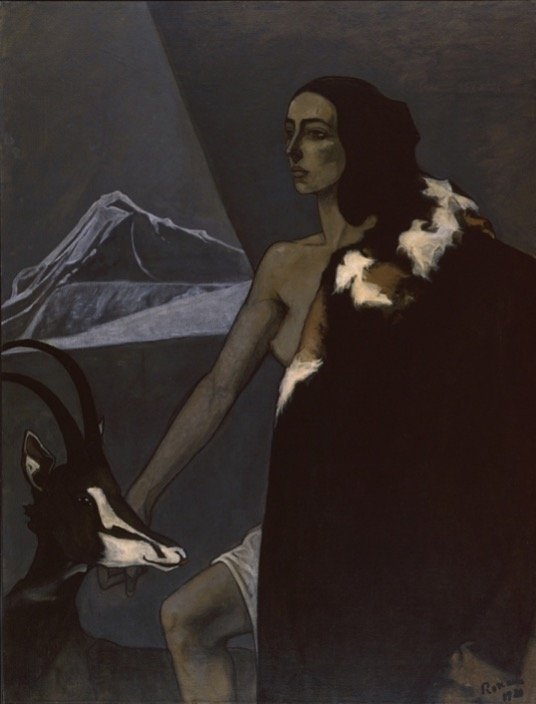ELIZABETH EYRE DE LANUX
(Pennsylvania 1894 – 1996 New York)
Portrait of Malvina Hoffman
Signed and dated, lower right: “Malvina – Paris 1922 / Eyre de Lanux”
Graphite on paper
19 ¾ x 15 ¼ inches (50.2 x 38.7 cm)
Provenance:
The artist; by whom given to:
Malvina Hoffman (1885–1966); by descent in the family, until 2024.
Literature:
Betsy Fahlman, “Eyre de Lanux,” Woman’s Art Journal, vol. 3, no. 2 (Autumn 1982–Winter 1983), p. 46, fig. 3.
This striking, large-scale portrait drawing depicts the American sculptor Malvina Hoffman. Malvina Hoffman’s career as an artist began in her hometown of New York City, where she studied painting and sculpture. Through her early works, Malvina gained the recognition of American sculptor Gutzon Borglum—the first in a significant list of American sculptors with whom she studied. Following the premature death of her father, Malvina eventually moved to Paris with her mother, and she became a student of Rodin. Hoffman dedicated her career to capturing the features and expressions of hundreds of sitters across the world, many of whom she met during her extensive travel as part of the commission for the Hall of Man at the Field Museum in Chicago. While the artist is perhaps best known the for the diverse range of people she captured in sculpture, here she is the model and the subject of this engaging drawing by the American artist, writer, and designer Elizabeth Eyre de Lanux—a fellow ex-patriot in Paris.
Born Elizabeth Eyre in New York, the artist sailed to France in 1918 with her husband, Pierre de Lanux, and shortly thereafter became professionally known as Eyre de Lanux. After settling in Paris, she enrolled in the Académie Ranson, the Académie Colarossi, and the Académie de la Grande Chaumière. Together with her husband, Eyre de Lanux led a full and colorful life in Paris. They were neighbors and close acquaintances of Natalie Clifford Barney, the American heiress and writer, who hosted a famed literary salon that brought together an international group of artists and authors. The salon, which occurred frequently just across the street from Eyre de Lanux’s home, was where the artist came to know many of the outstanding figures of the time, including Henri Matisse, Pablo Picasso, James Joyce, and Gertrude Stein. As hostess of the salon, Natalie Clifford Barney aimed to promote the work of female artists—and especially writers—eventually founding an academy for women.
As an integral member of Barney’s circle, Eyre de Lanux came to know the American painter Romaine Brooks, with whom Barney had a relationship which lasted over 50 years. While she was married to Pierre, Eyre de Lanux also engaged in intermittent relationships with both Barney and Brooks. Glimpses of these relationships can be observed in the artworks made during this time. After expressing a desire to depict Eyre de Lanux, Romaine Brooks portrayed her in Chasseresse as a semi-nude, female warrior (Fig. 1). In response, Eyre de Lanux drew Romaine Brooks in an alluring portrait (Fig. 2), which is not far in style or date of execution from the present drawing. Eyre de Lanux also portrayed Natalie Clifford Barney in an intimate portrait drawing (Fig. 3).
As an American female artist in Paris, Malvina Hoffman partook in the social scene surrounding Barney’s salon, befriending Romaine Brooks and Gertrude Stein, and ultimately sitting for this portrait drawing by Eyre de Lanux. The drawing is part of a larger body of early work by Eyre de Lanux which centered around women depicted frontally with direct, unyielding gazes. Studied from life, the drawing was made in Paris in 1922, and its Art Deco-style is in keeping with the moment in which it was created. Malvina was among the fellow artists who encouraged Eyre de Lanux’s artistic work, but her output remained small and is rare on the art market today. She is perhaps best remembered as a significant designer of the Art Deco period.
Fig. 1. Romaine Brooks, Chasseresse, 1920, Smithsonian American Art Museum, Washington DC.
Fig. 2. Elizabeth Eyre de Lanux, Portrait of Romaine Brooks, 1923, whereabouts unknown.
Fig. 3. Elizabeth Eyre de Lanux, Portrait of Natalie Clifford Barney, ca. 1921, Smithsonian American Art Museum, Washington DC.




